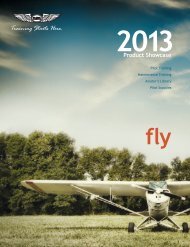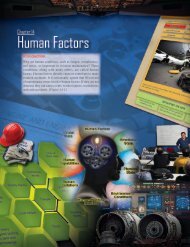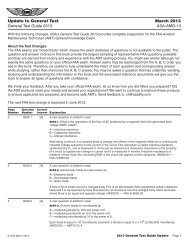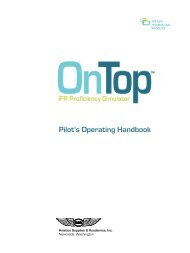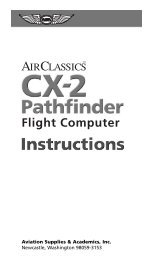E6-B Flight Computer Instructions - Aviation Supplies & Academics
E6-B Flight Computer Instructions - Aviation Supplies & Academics
E6-B Flight Computer Instructions - Aviation Supplies & Academics
Create successful ePaper yourself
Turn your PDF publications into a flip-book with our unique Google optimized e-Paper software.
The Slide Rule Side<br />
The term “circular slide rule” shouldn’t be intimidating.<br />
This side of your computer simply consists of a<br />
rotating disk with numbers on the middle scale,<br />
which when set against similar numbers on the<br />
fixed portion (outer scale), allows you to solve<br />
problems of time, speed, and distance, calculate<br />
fuel consumption, and make conversions between<br />
measurements such as statute and nautical<br />
miles. The inner scale on the rotating disk is<br />
graduated in hours. The slide rule side also has<br />
“windows” that you will use to solve airspeed and<br />
altitude problems.<br />
You can see that the number 60 on the rotating<br />
disk is marked differently than the other numbers.<br />
That is because most of your problems will be<br />
concerned with time —“something” per hour, either<br />
miles or gallons. Before you get to that, you should<br />
learn how to read and interpret the numbers on both<br />
portions of the slide rule side.<br />
Rotate the disk until all of the numbers on the<br />
middle scale match up with the numbers on the<br />
outer scale —10 will be at the top. However, that<br />
number “10” may be read as “.1,” “1,” “100,” or<br />
“1,000” depending upon the context of the problem.<br />
For now, read it as 10. The next number to the right<br />
is 11, so each life (or mark) of calibration between<br />
the two numbers is equal to .1, and you would read<br />
them as 10.1, 10.2, 10.3, etc. If you were solving a<br />
problem involving 1,000 pounds of fuel, the number<br />
10 would be read as 1,000, and each calibration<br />
would be equal to 10 pounds, and the 11 would be<br />
read as 1,100 pounds. See Figure 1.<br />
5



